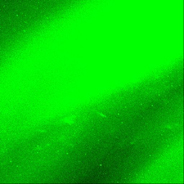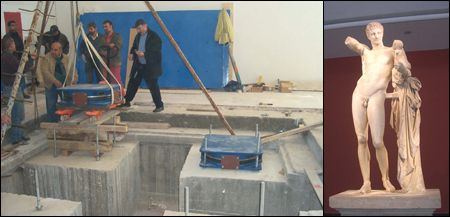
 On
Mar. 10, 2004, a group of researchers in Alaska watched their computer screens
as they sent pulses of energy into the night sky, almost 1 megawatt every 7 seconds,
or enough energy to power several hundred homes for a day. As the hour-long experiment
unfolded, they were surprised to see indications of something that had never been
done before: The energy beams had excited electrons in the atmosphere about 100
kilometers up that then dissociated from their nuclei and flashed green —
the first time scientists had created an artificial aurora that was visible to
the naked eye. The experiment had unexpectedly worked.
On
Mar. 10, 2004, a group of researchers in Alaska watched their computer screens
as they sent pulses of energy into the night sky, almost 1 megawatt every 7 seconds,
or enough energy to power several hundred homes for a day. As the hour-long experiment
unfolded, they were surprised to see indications of something that had never been
done before: The energy beams had excited electrons in the atmosphere about 100
kilometers up that then dissociated from their nuclei and flashed green —
the first time scientists had created an artificial aurora that was visible to
the naked eye. The experiment had unexpectedly worked. Sometime
between 370 and 340 B.C., the Greek sculptor Praxiteles is believed to have
carved a statue of Hermes, the herald of the Olympian gods, holding the infant
Dionysos, the Greek god of wine. Although it has survived for more than 2,000
years in a seismically active land and currently is housed in its own room in
the Archaeological Museum of Olympia in Greece, the world-renowned statue has
recently received new protection.
Sometime
between 370 and 340 B.C., the Greek sculptor Praxiteles is believed to have
carved a statue of Hermes, the herald of the Olympian gods, holding the infant
Dionysos, the Greek god of wine. Although it has survived for more than 2,000
years in a seismically active land and currently is housed in its own room in
the Archaeological Museum of Olympia in Greece, the world-renowned statue has
recently received new protection.
Arguably one of the most important statues in Greece, Hermes holding the infant
Dionysos (below right) has recently been seismically isolated to protect it
in the event of an earthquake. Four blocks placed under a concrete base beneath
the statue will allow the statue to swing like a pendulum in a quake, rather
than crash to the floor. Courtesy of Michael Constantinou, University at Buffalo.
Seismic engineers at National Technical University in Athens and the University
at Buffalo in New York recently completed retrofitting Hermes with a system
designed to preserve the statue should a large earthquake strike near Olympia.
In the event of a quake, the system allows the statue to gently sway side to
side like a pendulum, rather than toppling over and crashing to the floor, says
Michael Constantinou, an engineer at Buffalo who worked on the project.
The marble statue of Hermes is about 7 feet tall and stands atop a 3-foot-tall
base. The entire structure weighs about 6,600 pounds. Beneath the marble base
is a newly constructed concrete base built to support the seismic isolation
system.
A carpet with some cushions underneath used to surround the statue to provide
earthquake protection, Constantinou says. If an earthquake struck, the statue
would have fallen on the cushions and broken into large pieces that could be
easily put back together. Many statues around the world are protected this way,
he says.
In the case of Hermes, however, the Greek Ministry of Culture wanted more safeguards,
Constantinou says, so engineers began designing a system using friction pendulum
bearings that seismically retrofit structures around the world, especially freestanding
structures such as bridges and important buildings. The technology had not been
applied to something as small as a statue before, he says, so it was challenging
to figure out the geometry and exactly how much strength was needed to protect
the statue. Additionally, Constantinou says, “we were working against a
clock — this thing had to be sparkling by the time the Summer Olympics
in Athens began” last August.
Beginning in late 2003, the engineers ordered custom-built friction pendulum
bearings — 3-feet-by-3-feet square blocks that are about 8 inches high
— from a company in San Francisco. The bearings were shipped to Buffalo,
where the engineers tested them “in specially designed machines to determine
that their properties met the specifications of the project,” Constantinou
says. Then they shipped the bearings to Greece, where engineers installed them
beneath the concrete base.
The system has yet to be tested by an actual earthquake, but it is designed
to withstand a temblor as big as magnitude 8 — the maximum-sized quake
that is thought to be possible in the region. The last large earthquake that
struck Greece was magnitude 7, in 1983.
In addition to seismically protecting Hermes itself, the building in which the
statue stands has been seismically “strengthened,” Constantinou says,
so that in the event of an earthquake, the building may be damaged but should
not collapse. After all, “it’s not much good having the statue survive
a quake if it then gets crushed by the building,” says Andrew Stewart,
an art historian at the University of California, Berkeley. “As one of
the most important statues in Greece, Hermes “deserves special treatment,”
he says.
When combined with strengthening a building, such as by adding columns or putting
up a new wall, seismically isolating single features is a good option to protect
important artifacts when it is too difficult or costly to seismically isolate
the entire building, Constantinou says. But it is no easy task, he says, “to
convince the administrators and archaeologists that the system will behave properly
in the event of a quake.”
Megan Sever
 |
Geotimes Home | AGI Home | Information Services | Geoscience Education | Public Policy | Programs | Publications | Careers |